-
糖尿病足溃疡是糖尿病的常见并发症。糖尿病足由于下肢血管及神经病变,形成足部溃疡, 可导致软组织缺损、骨髓炎、骨质破坏、甚至有截肢的风险等,严重影响病人的生活质量[1]。临床治疗糖尿病足溃疡的方法很多,而治疗关键在于促进创面的愈合。负压创面治疗(negative pressure wound therapy,NPWT)广泛应用于开放性创伤治疗和护理[2]。NPWT用医用海绵覆盖创面,利用透明薄膜将创面完全封闭,外部连接负压吸引促进引流,可以加速创面愈合[3]。银离子水凝胶敷料具有广谱的抗菌作用,对细菌、真菌均有效[4]。目前使用NPWT联合银离子水凝胶敷料治疗和护理糖尿病足溃疡病人的报道较少。我们将NPWT与银离子水凝胶敷料联合应用于糖尿病足的护理并与NPWT、银离子水凝胶敷料单独应用的效果进行比较。现作报道。
HTML
-
选取我科2015年1月至2018年6月收治的101例糖尿病足溃疡病人,随机分为3组,银离子水凝胶敷料组(A组),NPWT组(B组)以及NPWT和银离子水凝胶敷料联合组(C组)。纳入标准:(1)符合糖尿病足诊断标准;(2)Wagner分级2~4级;(3)清创后创面面积>3 cm2。排除标准:(1)正在服用糖皮质激素、免疫抑制剂及化疗药物者; (2)病人一般情况差,不能耐受清创手术;(3)下肢中重度血管病变者; (4)需手术截肢者。3组病人性别、年龄、糖尿病病程、糖尿病足病程、创面面积、糖化血红蛋白、Wagner分级差异无统计学意义(P>0.05)(见表 1)。
分组 n 男 女 年龄/岁 糖尿病病程/年 糖尿病足病程/d 创面面积/cm2 Wagner分级 糖化血红蛋白/% 2级 3级 4级 A组 32 23 9 57.78±7.30 9.25±4.70 31.78±29.47 16.27±10.12 10 16 6 8.19±1.29 B组 34 24 10 59.76±9.91 9.08±6.06 36.88±32.31 18.95±9.35 11 18 5 8.12±1.28 C组 35 23 12 59.97±8.26 11.11±16.77 35.14±31.72 18.66±11.12 13 18 4 7.82±1.48 F — 0.34* 0.65 0.37 0.23 0.68 0.83△ 0.74 P — >0.05 >0.05 >0.05 >0.05 >0.05 >0.05 >0.05 MS组内 — — 73.598 116.924 975.328 104.735 — 1.838 *示χ2值; △示Hc值 -
所有病人入院后第一天均进行糖尿病相关知识宣教,协助制定糖尿病食谱,监测病人血糖、血压及血脂,并给予药物治疗。足部溃疡清创后行细菌培养,根据药敏试验结果予以抗生素治疗。
-
A组:使用康乐保(Coloplast)医疗用品有限公司生产的水凝胶(康惠尔清创胶)与银离子藻酸盐敷料,足部溃疡清创后将银离子敷料用水凝胶湿润后覆盖创面或填塞至深部,以无菌纱布和棉垫覆盖包扎固定,每隔2 d换药一次,或外层纱布有明显渗出时及时换药。每次换药行细菌培养至结果阴性。
B组:使用武汉维斯第医用有限公司的护创材料,清创后用医用泡沫海绵按照伤口形状大小进行剪切后覆盖创面,以无菌半透明薄膜封闭创面,使薄膜与创面周围皮肤贴合良好,保证创面内负压效果。海绵内多孔的硅胶管通过三通连接负压吸引装置。负压吸引压力设置为75~150 mmHg。每隔3~5 d打开封闭创面,根据创面愈合情况进行换药或重新护创引流。每次换药行细菌培养至结果阴性。
C组:清创后将水凝胶湿润银离子敷料后覆盖创面或填塞至深部,以高分子医用泡面海绵根据创面形状大小剪切后覆盖创面,以无菌半透明薄膜封闭创面,使薄膜与创面周围皮肤贴合良好,同B组法连接负压吸引装置负压吸引压力50~150 mmHg。其他处理同B组。
-
记录经治疗后第1周、第2周、第3周创面的肉芽生长积分,创面的愈合时间, 抗生素使用时间,换药次数以及每人次平均换药时间以及每人次换药费用。其中肉芽生长积分的计算方法如下:肉芽覆盖完全覆盖或愈合记0分;肉芽覆盖创面>75%记2分;51%~75%记4分;26%~50%记6分; < 26%记8分。每人次换药时间=该组总换药时间/该组病例数。每人次换药费用=该组总换药费用/该组病例数。
-
采用方差分析、q检验、χ2检验和秩和检验。
1.1. 一般资料
1.2. 治疗方法
1.2.1. 常规治疗
1.2.2. 分组治疗
1.3. 评价指标
1.4. 统计学方法
-
3组病人创面愈合时间A组最长,B组次之,C组最短(P < 0.05~P < 0.01);抗生素使用时间C组短于A组和B组(P < 0.05~P < 0.01),A组和B组差异无统计学意义(P>0.05)(见表 2)。
分组 n 创面愈合时间 抗生素使用时间 A组 32 50.63±17.28 15.81±5.76 B组 34 41.85±18.74* 16.79±4.84 C组 35 33.34±16.70**△ 12.57±5.63*△△ F — 8.07 5.73 P — < 0.01 < 0.01 MS组内 — 309.469 29.380 >q检验:与A组比较*P < 0.05, **P < 0.01;与B组比较△P < 0.05, △△P < 0.01 -
3组病人第1周肉芽生长积分差异无统计学意义(P>0.05);第2周、第3周A组和B组、B组和C组差异无统计学意义(P>0.05),C组积分低于A组(P < 0.05和P < 0.01)(见表 3)。3组病人典型病例的肉芽生长图片见图 1。
分组 n 肉芽肿生长积分/分 Hc P 8 6 4 2 0 第1周 A组 32 18 12 2 0 0 B组 34 16 15 3 0 0 0.56 >0.05 C组 35 19 11 5 0 0 第2周 A组 32 14 14 3 1 0 B组 34 10 11 8 5 0 6.41 >0.05 C组* 35 10 10 8 6 1 第3周 A组 32 9 11 8 2 2 B组 34 5 8 11 7 3 14.55 >0.05 C组** 35 2 6 9 11 7 与A组比较*P < 0.05, **P < 0.01 -
3组病人换药次数和每人次换药时间,B组和C组均明显短于A组(P < 0.01),B组和C组差异无统计学意义(P>0.05)。3组病人每人次换药费用比较,A组和B组、B组和C组差异均无统计学意义(P>0.05),A组高于C组(P < 0.05)(见表 4)。
分组 n 换药次数 每人次换药时间/min 每人次费用/元 A组 32 16.59±6.39 222.13±131.23 5 973.75±2 298.51 B组 34 9.35±4.45** 128.29±94.23** 5 306.17±1 967.20 C组 35 8.77±4.29** 126.83±97.94** 4 586.85±2 240.04* F — 24.05 8.21 3.42 P — < 0.01 < 0.01 < 0.05 MS组内 — 25.969 11 765.4 984 715 183.6 q检验:与A组比较*P < 0.05, **P < 0.01
2.1. 3组病人创面愈合时间及抗生素使用时间比较
2.2. 3组病人前3周肉芽生长积分比较
2.3. 3组病人换药次数、每人次换药时间、每人次换药费用比较
-
糖尿病足溃疡是糖尿病常见的并发症。糖尿病足溃疡创面的愈合是临床工作中的一个重要挑战[5]。本研究中,在创面愈合时间、抗生素使用时间、第2周及第3周肉芽生长积分等方面,NPWT联合银离子水凝胶敷料组对比单独使用银离子水凝胶敷料组,具有明显的改善效果,而换药工作量却明显减少。在创面愈合时间以及第3周肉芽生长积分等方面,NPWT联合银离子水凝胶敷料组对比单独使用NPWT组,具有明显的改善效果。在创面处置费用上,NPWT联合银离子水凝胶敷料组与单独使用银离子水凝胶敷料组相比明显减少,而与单独使用NPWT组相比无明显差异,在费用上并未增加病人的经济负担。
自20世纪90年代发明以来,NPWT在创伤治疗护理中的应用越来越广泛。与传统换药相比,NPWT可以有效地促进糖尿病足溃疡的愈合,减小创面面积、缩短创面愈合时间,降低截肢率[6]。NPWT通过对创面组织施加负压,使创面周围组织内聚,促进创面缩小、愈合。负压同时增加了毛细血管血流,缓解组织水肿,促进肉芽组织生成,形成新生血管。利用引流可以去除创面表面坏死组织,减轻感染负荷,促进创面周围组织生长[7-8]。
银离子水凝胶敷料具有广谱抗菌作用,被广泛应用于预防伤口感染以及治疗感染伤口。ZIEGLER等[9]证实对于慢性难愈合创面,银离子水凝胶敷料具有良好的抗菌作用,能够促进肉芽组织新生并上皮化。银离子水凝胶敷料含有纳米级的银离子颗粒,可以显著的增大银离子的表面积,提高其抗菌作用。带电荷银离子颗粒可以黏附并穿透细菌的细胞壁,破坏细菌DNA,抑制部分蛋白及酶的合成,增加细胞壁的透性。此外,银离子还可以产生活性氧[10-11]。
本研究中,C组与A组、B组在抗生素使用时间等方面具有明显差异,提示银离子水凝胶敷料可以有效控制创面的感染。黄奕燕等[12]在一项对比研究中也证实含银离子水凝胶敷料可以更有效地降低糖尿病足创面的感染率。
NPWT使用的填充物会对压力分布、渗出物引流以及肉芽组织生长产生影响[13]。常用的填充物包括泡沫敷料和纱布等。GERRY等[14]报道了使用银离子水凝胶敷料作为填充物治疗2例病人下肢溃疡,提示NPWT联合银离子水凝胶敷料对难治性慢性溃疡创面具有良好的治疗作用。
尽管材料费用及日常护理费用较多,但NPWT仍是促进创口愈合的经济有效的治疗方法[15]。本研究中,因为减少了换药次数,缩短了治疗时间,与银离子敷料治疗相比,NPWT联合银离子敷料减少了病人的治疗费用,而与NPWT相比,NPWT联合银离子敷料并未增加病人的治疗费用。
综上所述,NPWT联合银离子水凝胶敷料可以促进肉芽组织生长,缩短糖尿病足溃疡创面的愈合时间,减少抗生素使用时间,而不增加换药工作量以及创面处置的治疗费用,具有临床应用价值。但此项研究纳入病例较少,仍需增加病例数进一步深入研究。








 DownLoad:
DownLoad: